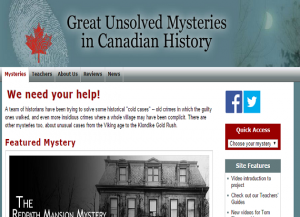On Friday, February 6th 2015, I was privileged to speak with associate professor John Lutz of the University of Victoria. Professor Lutz teaches Native History, but is also heavily involved in several digital public history projects. His story begins around 2000, when Professor Lutz began collaborating with colleague Ruth Sandwell about a historical murder involving Native and Black Canadians. As they shared knowledge and dove deeper into the research, they discovered that there was enough evidence available to question the outcome of the trial; perhaps not enough to make irrefutable claims, but certainly enough to list several other suspects. Over the next several years, Lutz and Sandwell would develop their research into a murder mystery series, targeted for school age students (but also enjoyed by the general public). The Great Unsolved Mysteries in Canadian History website was born, including dozens of other mysteries researched by collaborators all over Canada. The website would serve to not only teach the public about their Canadian history, but also to teach critical history skills; such as research, analysis, comparison of contradictory sources, and deductive reasoning.
Professor Lutz has gone on to work with many other digital platforms such as Google Sketch Up, GIS, Wikis, and student published websites. He was fortunate enough to learn a coding skills before he began his tenure at the University and he has been a part of Web 2.0 from the beginning. I was delighted to have Professor Lutz’s expertise for this interview, because I am interested in doing exactly what he has already done. I would like to combine my teaching, historic, and digital skills to bring historic knowledge and methods to the general public. My questions to Professor Lutz focused on his interactions with the public and his involvement with digital tools.
Although he is primarily employed in the academic sphere, Professor Lutz has constant interactions with public entities. He emphasized the marriage of academia and public history, noting that history is not some frill to be kept in an ivory tower, but is instead a civic duty. It is a historian’s duty to educate the public and help fix misconceptions, but it also the civic responsibility of the public to deeply understand their roots and value the lessons learned from history. Professor Lutz is helping to develop a Public History Master’s program at his university, which will give practical experience in the community to the graduate students.
Professor Lutz encouraged me to develop several important skills to be a part of this field. A historian interested in digital projects does not need to be an expert in all technical aspects, but a certain level of comfort is necessary. He admitted that he has deficiencies in all the digital programs that he uses, but he has enough technical knowledge that he can recognize where he needs to go for help and who needs to be involved for the project to be successful. He also stressed how important pedagogy was. He encouraged me to tap into my experience as a teacher to become a public historian who could engage with the public in a real and relevant manner. He inspired curiosity. The digital world is constantly changing and if I want to be a part of it, I must be willing to get messy, make mistakes and try new things. His last piece of advice was really fascinating. He encouraged me to get in on the ground level of gaming technology in history. Simulated reality is one of the best methods for learning and the potential to develop history games has yet to be tapped in to.
Professor Lutz mentioned the difficulties of funding and encouraged me to seek many different avenues for finding money. He was fortunate to receive government grants for the Great Unsolved Mysteries in Canadian History website, but he was still required to raise additional funds. Although he warned that it takes work and perseverance, he was optimistic about finding money for these types of projects.
The Great Unsolved Mysteries in Canadian History website has around 2,500 visitors every day, ranging from Canadian students, to English language learners around the globe, to Australian students studying colonialism. He has created a history tool that is not only creative and interesting, but also useful. I hope to emulate him in my future endeavors.

I went to the website and enjoyed the experience. I never made it to the “whodunit” part because I delved into the links to the primary documents that contextualized (ethnicity, religion, poverty, immigration, opportunity) the mystery. It seems like a great way to get teens or anyone with an interest in history or mysteries engaged at a variety of levels.